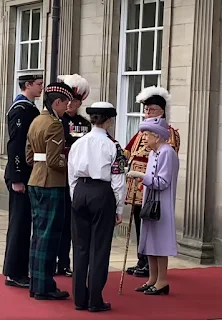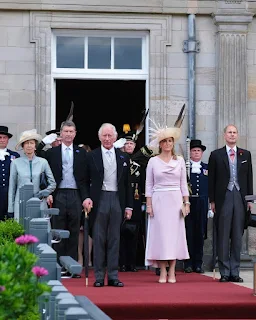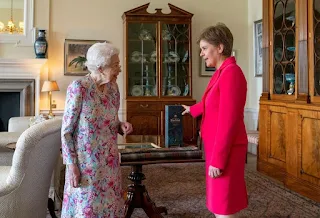Queen Elizabeth II is currently in Scotland for her annual "Holyrood week". A significant ceremonial duty she annually performs in Scotland where she carries public engagements such as investiture, garden party, and receiving audiences at Holyroodhouse.
 |
| The Queen attends military parade at the Palace's grounds |
Her Majesty, 96, has scaled back public engagements since October 2021 due to the issue of mobility. Her presence in Scotland this month was not expected due to the long journey north from Windsor Castle.
 |
| Ceremony of Keys at Edinburgh Castle |
Upon arrival on Monday, June 27, she attended the Ceremony of the Keys held at the courtyard of the Palace of Holyroodhouse, which signaled her week-long stay in Scotland's capital, Edinburgh.
She also performed the same ritual when she visited Edinburgh Castle.
Traditionally, her children accompany her to Scotland during this week-long celebration, attending public events. This year, the Duke of York is not part of the royal party as he no longer carries public duties.
 |
| Princess Anne, Sir Tim Laurence, Prince Charles, the Earl and Countess of Wessex |
The Queen's three children, Prince Charles, Princess Anne, and Prince Edward, accompanied by their respective spouses (except the Prince of Wales), hosted a Garden Party held on the grounds of the Palace of Holyroodhouse. It will be the last Royal Garden Party for this year.
On Wednesday, June 29, The Queen received Scotland's First Minister Nicola Sturgeon, at her sitting room in the Palace of Holyroodhouse.
Details of their conversation, or what transpired during the meeting, were not released. But Her Majesty appeared in good shape, and did not use a walking stick when meeting Sturgeon, according to video footage.
 |
| The Queen and Nicola Sturgeon. Photos Jane Barlow/Pool via REUTERS |
The clip also showed Sturgeon presenting the monarch with a £150 ($181) bottle of top-end Johnnie Walker Blue Label Whisky.
Whisky is the national liquor of Scotland.
 |
| The Queen and Nicola Sturgeon. Photos Jane Barlow/Pool via REUTERS |
Second Scottish Independence Referendum
On June 28, Tuesday, Sturgeon, pushed in holding another independence referendum. The Scottish leader wants to split with the United Kingdom, and on Tuesday, he announced plans for a referendum to be held on October 19, 2023.
 |
| The Queen and Nicola Sturgeon. Photos Jane Barlow/Pool via REUTERS |
Addressing the Edinburgh parliament, Sturgeon conceded that her devolved administration may lack the power to call the vote without London's approval and is seeking an opinion from the UK Supreme Court.
In 2014, Scotland held the first Independence Referendum. Voters were asked: "Should Scotland be an independent country?" 44.7% of voters answered "Yes" and 55.3 percent answered "No".
However, a lot of things have changed since 2014, particularly since the UK voted to leave the European Union in a June 2016 referendum and the pro-independence parties increased their majority in the 2021 Scottish Parliament election, Thus, Sturgeon proposed a second referendum on independence.
British Prime Minister Boris Johnson says the 2014 plebiscite had already settled the matter for a generation. But vowed to study Sturgeon's plan and "respond properly".
What's really the plan of Sturgeon's party?
Are they going to switch to a republic or revive the House of Stuart? Sturgeon's Scottish National Party (SNP) wants to keep the monarchy after independence, and wants the queen to remain as head of state.
As a constitutional monarch, Queen Elizabeth II is above politics and is always neutral with political matters, but observers commented that her presence in Scotland this week is a subtle reminder of Scotland's three centuries-old union with England.
The birth of Great Britain
Before the death of Queen Elizabeth I of England in 1603, England and Scotland were two separate kingdoms. And unlike other territories during medieval times united through conquests and invasions, these two countries were united through a personal union because the unmarried Elizabeth I died without children to inherit the English crown.
Her nearest relative to succeed was King James VI of Scotland, son of the woman whom she sent to the block, Mary Queen of Scots.
Mary Queen of Scots was a granddaughter of Princess Margaret Tudor, the older sister of Elizabeth I's father, King Henry VIII.
James was the only child of Mary Queen of Scots and her second husband, who was also her first cousin, Henry Stuart, Lord Darnley.
Henry was the son of Lady Margaret Douglas, the daughter of Princess Margaret Tudor with her second husband, the 6th Earl of Angus, making James the strongest claimant to the English throne.
Following the death of Elizabeth I in 1603, James VI of Scotland ascended the English throne as James I. But England and Scotland were not officially recognized as a single kingdom of Great Britain until the 1706 Treaty, which was ratified by the Acts of Union of 1707.
The Act of Settlement 1701
The Act of Settlement 1701, was passed to block the Catholic descendants of King James I from inheriting the British crown, following the Glorious Revolution that ousted his grandson, the Catholic King James II.
The Act of Settlement 1701 stated that the British throne should only be passed to the protestant descendants of Electress Sophia of Hanover (granddaughter of James I). Sophia predeceased Queen Anne.
When Queen Anne died in 1707 without issue, the British throne was inherited by Sophia's son, George of Hanover, bypassing all the Catholic descendants of Charles I who were ahead in the line of succession than George I.
Today, the Act of Settlement 1701 remains one of the main constitutional laws that governed the British throne succession.
Should Scotland declare independence and reject the Act of Settlement of 1701, and wants to restore a Stuart monarch, then Scotland's king might be a German prince, Franz, Duke of Bavaria. He is the most senior male descendant of King James I, He is the paternal uncle of Princess Sophie, the Hereditary Princess of Liechtenstein.
Nicola Sturgeon of the Scottish National Party insisted that her party does not aim to expel the Queen as head of state. And wants to retain the monarchy after Scotland becomes an independent country.
So what is the aim of becoming an independent country if they want to retain the British monarch as their head of state?











0 Comments